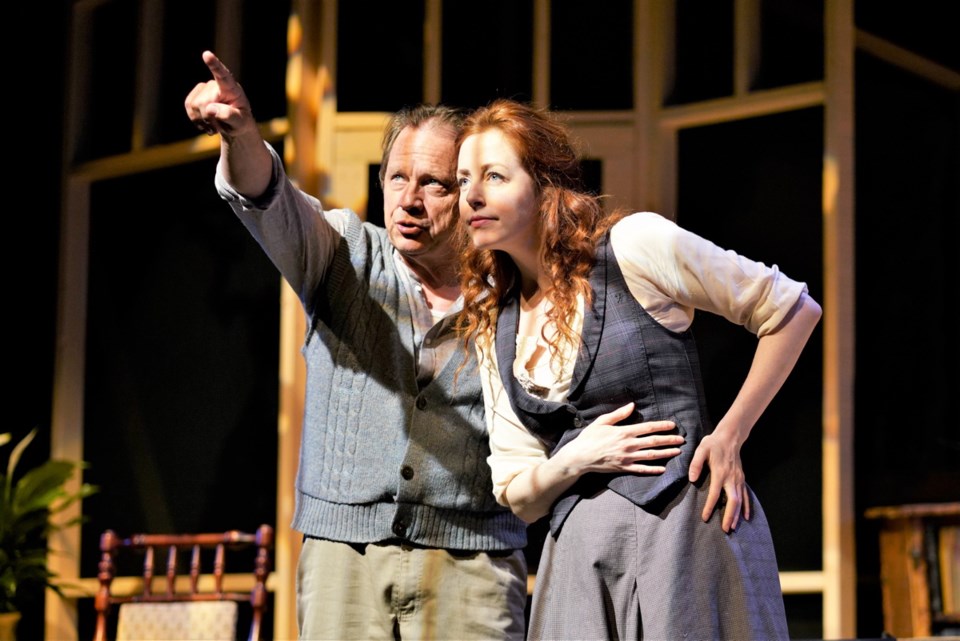When it comes to playwright Henrik Ibsen, most of us are familiar with Hedda Gabler and A Doll’s House. Less known is The Master Builder, a peculiar and intriguing 1892 drama being revived by Blue Bridge Repertory Theatre at the Roxy Theatre.
The play, directed by Brian Richmond using an adaptation by David Hare, is about middle-aged Norwegian architect Halvard Solness. He has achieved enviable success, but fears his achievements will be overshadowed by the younger generation nipping at his heels.
Solness (David Ferry) is a quivering mass of contradictions: vain, unconfident, guilt-ridden, arrogant, torn between duty and desire.
Enter mysterious Hilde Wangel, played by Amanda Lisman. Visiting Solness’s home unannounced, Hilde insists Solness made romantic overtures when she was just a teen. Now, 10 years later, she has come to collect on his promise — that Hilde would be his “princess” and he would build her a castle. Eventually, she goads him into climbing a tower on his just-completed building, resulting in a tragic finale.
The Master Builder met with a decidedly mixed reception upon its debut. Some declared the strange play to be as loony as the madness into which Solness fears he has descended. It might be helpful to view it as Ibsen’s semi-autobiographical examination of an artist’s life.
Solness achieves creative success at the expense of others and ultimately suffers an Icarus-like fate. His triumphs seem curiously heaven-sent, and yet he leaves behind a trail of ruined lives, including those of his assistant Ragnar (Rod Peter Jr.), his book-keeper, Kaja (Emma Newton), and his long-suffering wife, Aline, well played by Jan Wood.
The Master Builder’s smorgasbord of capital-letter themes can seem like an overwhelming dog’s breakfast. There’s loss of religious faith, fear of mortality and the struggle between duty and sexual desire. Ibsen pivots between naturalism and symbolism while lobbing Freudian head-spinners (there’s much talk of the towers Solness likes to erect).
Hilde — possibly the product of Solness’s fevered imagination — is a wonderfully bold creation. She’s a Dionysian siren who shrugs off the shackles of societal respectability in favour of sensuality, poetry and idealism.
On Thursday, Lisman’s lynchpin performance was captivating: physical, passionate, erotically charged. She extolled Solness’s gifts with a devilishly mercurial passion. One lingering and powerful image is Lisman tossing her red hair while arching back seductively across a sofa.
Ferry, as Solness, is a strong presence. At times, his acting seemed overly understated in contrast to Lisman’s more heightened performance. That said, Ferry successfully conveyed the inner conflict of a tortured man at war with himself.
The production benefits from Graham McMonagle’s bare-bones set, notable for a burlap-look backdrop resembling a cliff face. This was illuminated imaginatively by Giles Hoyga, with shifts in light paralleling the rhythms of speech. Brooke Maxwell’s mysterious music/soundscape also contributes to The Master Builder’s other-worldly atmosphere.
The show continues at the Roxy to June 9.
***
In their 1960s/’70s heyday, Frankie Valli and The Four Seasons never got the critical acclaim enjoyed by other chart-topping contemporaries.
Perhaps their doo-wop harmonies sounded dated in the love-’n’-peace age. Or maybe it was Valli’s astonishing falsetto, which for some is an acquired taste and, for others, a thrilling pop confection.
The truth, as the jukebox musical Jersey Boys proves, is that The Four Seasons were a musical force to be reckoned with. Much thanks goes to member Bob Gaudio, a pop wunderkind who composed such songs as Sherry (the band’s first hit), Big Girls Don’t Cry, Walk Like a Man, Dawn (Go Away) and Rag Doll.
Gaudio gets his full due in Jersey Boys, concluding its run at the Royal Theatre with two shows today and two more on Sunday. The only “official” Broadway touring production (and the same one that played Toronto’s Ed Mirvish Theatre recently), it’s a worthwhile show boasting superior singing, snappy choreography and fast-paced direction. Fans of the music won’t be disappointed — and those coming late to the party will also find plenty to enjoy.
Jersey Boys follows a loosely documentary style. It’s a familiar show-biz trope: a band works hard for success, succeeds despite obstacles, enjoys the riches and then struggles with the fissures that follow.
We first meet The Four Seasons during their New Jersey teen years. Opportunities for the Jersey boys were few — they included petty crime, jail and getting “mobbed up” (interestingly, actor Joe Pesci, renowned for his gangster roles, was a real-life pal of The Four Seasons and surfaces in the show as a minor character).
Music was another career option. We follow the boys as they work the nightclub circuit, provide anonymous background vocals in recording successions, then hit it big with the million-selling Sherry.
What made this song, and others, is Valli’s faux-castrato singing, which cannily captures adolescent angst and ecstasy with ice-pick potency.
On Wednesday night, Valli was ably played by understudy Tony Clements. (Regular Jonny Wexler, sidelined by a minor back complaint, returned to the show Thursday). The diminutive Clements not only looked the part, he bull’s-eyed the tricky high notes with a pleasantly nasal timbre.
Another standout was Corey Greenan, playing band member Tommy DeVito. DeVito is arguably the most interesting character, a street hustler and ex-con who was instrumental in the band’s rise and later racked up crippling gambling debts. Greenan, a good singer, exuded such 1,000-watt swagger and energy, it was hard to look away.
Sergio Trujillo’s choreography is a hoot. Precise, geometric dance moves are dispatched with hyper-realistic zeal. Equally enjoyable — and campy — are the costumes, a 1960s wet dream of two-tone shirts and bouffant hair.
Director Des McAnuff, a former artistic director of the Stratford Festival, moves the short, TV-like scenes along with rock-and-roll energy.



